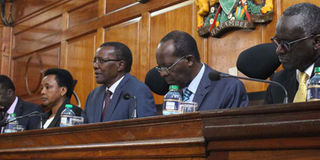No clarity needed in ruling, judges insist

Chief Justice David Maraga (center), flanked by other Supreme Court judges on September 9, 2017, gives the electoral agency directions on whether the IEBC chairman can correct errors in the presidential election results forms. PHOTO | KANYIRI WAHITO | NATION MEDIA GROUP
What you need to know:
- Justice Mwilu told Mr Muite that she could not recall the court telling IEBC to verify results at the national tallying centre.
- Form 34B, filled at the constituency tallying centre, is the aggregate of Forms 34A from polling stations.
The Supreme Court was treated to heated arguments on Monday as judges sought to understand what clarification the electoral commission was seeking.
Independent Electoral and Boundaries Commission lawyer Paul Muite said the court created the confusion and needed to clarify what the commission chairman should do “in case he notices errors in the presidential election results forms”.
Mr Muite told Chief Justice David Maraga, Deputy CJ Philomena Mwilu and justices Jackton Ojwang, Smokin Wanjala and Isaac Lenaola that the court criticised the commission for announcing the presidential poll results before verification.
RESULTS
He said while the Court of Appeal was clear that results, once announced at polling stations were final, the Supreme Court faulted IEBC chairman for announcing figures that did not add up.
Justice Mwilu told Mr Muite that she could not recall the court telling IEBC to verify results at the national tallying centre.
Mr Muite said: “We are seeking a clarification on how the presidential returning officer should go about verifying results before announcing the winner.”
TRANSMISSION
Mr Maraga then asked Muite to read Section 39(1)(c) of the Elections Act, which the senior counsel did and said he had no trouble understanding it.
“Perhaps, Chief Justice should explain what you mean,” Mr Muite said when Mr Maraga told him it was “that simple”.
The section reads: “The commission shall electronically transmit, in the prescribed form, the tabulated results of an election for the president from a polling station to the constituency tallying centre and to the national tallying centre.”
Mr Muite said it was not clear if the commission should use Forms 34A or 34B to announce the election outcome.
IEBC
Form 34B, filled at the constituency tallying centre, is the aggregate of Forms 34A from polling stations.
Mr Kamau Karori, also acting for IEBC, explained the dilemma the commission was facing.
“After verification, what happens?” he asked, adding that IEBC was ready to comply with an order given by the court.
Prof Ben Sihanya, for Nasa, said the commission was trying to appeal against the Maina Kiai case, yet the Supreme Court dealt with the matter by upholding the decision.
“Courts have been telling IEBC to follow the law, but it does not,” he said.
SUBMISSIONS
The Law Society of Kenya, through Mr Stephen Mwenesi, said the judges upheld the Court of Appeal decision.
Where is the error in the judgment?” he asked.
Mr Kiragu Kimani, who appeared for President Kenyatta asked the court to give directions on the matter.
But Mr Elias Mutuma, who appeared for Thirdway Alliance, opposed the case being heard at the Supreme Court, saying the party had also filed a petition seeking clarification on who should participate in the poll but the case was struck out.
The judges directed IEBC to file written submissions by the end of Monday while other parties file theirs Tuesday, ahead of the hearing on Wednesday.




